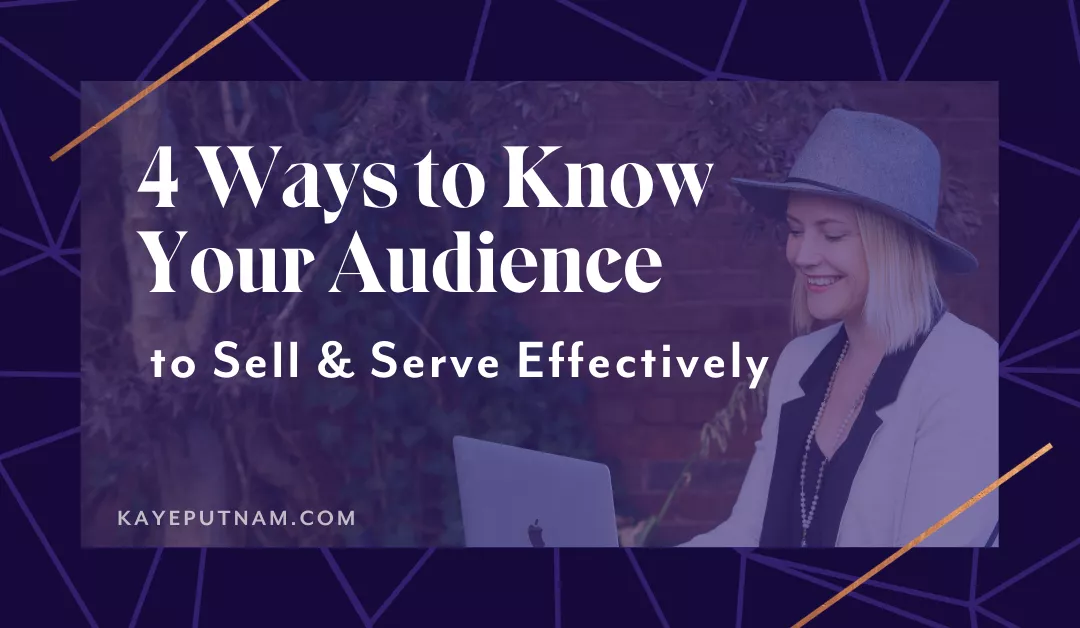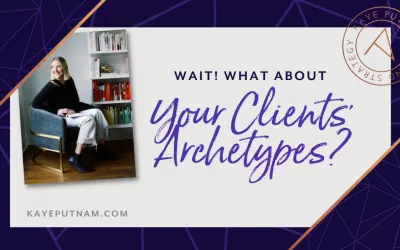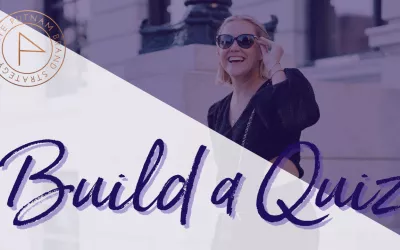When you’re getting started as an entrepreneur, one of the most important questions to answer is, “Who’s your ideal client?”
(And this isn’t just a question for new business owners, either. It comes into play any time you’re making a shift or selling a new product / service… You have to figure out how you’re going to talk about it, and refine your understanding of your ideal client – again and again!)
But guess what?
“Who’s your ideal client?” is one of the hardest things to answer, too. It can be pretty angst-producing, if we’re being honest, right? 😩
And then the additional questions begin…
What newspaper does he read? ⠀
⠀⠀⠀⠀⠀⠀⠀⠀
What’s her favorite breakfast cereal? ⠀
⠀⠀⠀⠀⠀⠀⠀⠀
Does she roll the toilet paper under or over? (Okay, I may be exaggerating a bit with this one. But maybe not. Some people are super into this avatar thing! 😉)
Anyway… you’re like, “How in the world am I supposed to know this stuff?”
It’s really the classic “chicken and the egg” paradox. You want to know your audience so you can attract clients and customers. But you need to work with people to truly know them.
So in this article, I’m going to share the four ways that I learn more about my audience – so that I can effectively serve and sell to them.
These are the techniques I use on a regular basis – in the online business I’ve been running for the last 8+ years. And I also teach these to my students and clients – most specifically in my Brand Advantage and my Amplify Accelerator programs.
Ready to dive in and learn? Perfect. You can press “play” on the video below if you’re inclined – or you can read on for the more detailed version of the lesson. (Or both!)
First things first: Ideal audience clarity is always evolving.
Before I share these four powerful “know your audience” tactics, I need you to make two shifts in your mindset about this entire exercise.
First, we need to frame this as an ongoing process – not a “one and done” thing.
If you come at these market research-y things thinking you need the exact perfect answers… then you’re setting yourself up for failure and disappointment. Full stop. 🤚🏾
Even after years in business, I still learn more about my ideal clients and my audience every. single. day. My understanding of what they want, what they need, their challenges and their most pressing desires?… It’s always improving and evolving.
I’m always getting more clarity.
Every single time I interact with somebody I’m learning more. And I’m incorporating that new insight into my messaging and my sales pages… and into the products that I develop to serve them. It’s an ongoing process.
So even if you’re currently thinking something like…
💬 “I’m just in the beginning.”
💬 “I’m mid-shift and I don’t know these answers!”
💬 “I thought I knew my person, but now this new information has emerged… Is it okay to pivot?”
… or anything like that!…
Understand that clarity is ongoing and comes with time. Know that it’s completely normal for these things to change and evolve.
Oh, and this. 👉🏼 👉🏼 👉🏼 That’s how every entrepreneur does it… (whether they admit that or not!) 😉
Okay, the second shift I need you to make? It’s coming in hot… 😘
Pin this article to reference later! 📌

Pin this article to reference later! 📌
Ideal audience work is like dating.
My hubby and I recently celebrated our 10-year wedding anniversary, so it’s admittedly been a long time since I’ve been on a first date. However I do (embarrassingly!) remember a point in my dating life when I made “the list.”
Writing a “perfect partner” wish list is relatively popular dating advice, from what I’ve heard. You list all the attributes of your ideal person – so you’ll know them when you see them.
So mine looked like this…
✔ I wanted him to be athletic.
✔ I wanted him to be smart.
✔ I wanted him to be kind.
✔ Oh and funny.
✔ And adventurous, too.
✔ And I wanted him to buy me flowers and small treats.
(There was more. 🤪)
Looking back, knowing what I know now – and having now been with my ideal amazing partner for the last 10 years – that list is honestly a liiiiiiiittle laughable.
It was actually a pretty good exercise, because it did help me get clear on my values and desires. But it didn’t end up being an *exact* preview of my future partner. In reality, my husband is so much better than any person I could have imagined in that early stage. (xoxoxo, B! 😘)
And the same thing is going to happen when you write out these “ideal client avatars” for your business. You’re making a lot of assumptions at first. You’re just guessing, essentially. But that gets you ready for the second step – where the real clarity comes.
That second step? It’s to just go out on dates with a bunch of people…. Errrrr… I mean, work with a bunch of different people. 😉
Work with some people that fit your ideal client avatar, sure.
Also, work with some people that don’t fit it – on purpose!
Basically – just like with dating – you don’t want to be overly-picky when you’re first starting your brand. Because you’re going to get so much intel from just interacting with real, live humans. You’ll learn so much – beyond just the four corners of your theoretical list.
And, as your business changes… as you release new programs… as you get interested in different and adjacent topics… Your ideal audience will also change over time. It will continually be morphing and evolving – and that’s okay.
So with all of that said… and now that we’ve busted the myth of the perfect, permanent ideal client avatar… 😉, let’s get into the four strategies that I use – to learn about and know my audience.
1. Have lots (and lots) of conversations.
I list this one first for a reason. If you do only one thing after reading this, do this! Have as many real, live conversations as possible.
For me, this is the number one way that I learn what people think, need, and want from me.
Every time I get on the phone, a Zoom call, a sales call, a market research call… I gain clarity. Even when I’m being interviewed by other peers or potential clients (for example on podcasts), I find ✨GOLD ✨ in those conversations.
So find ways that you can get on a call, get on a video chat with more of your ideal clients… However you need to do it – do that! 😀 This could mean offering free coaching calls or free strategy calls. Or you could just reach out to people to get to know them – positioning the conversation more as a coffee date, for example.
And, here’s a hack for you… I have Google docs called “Copywriting Inspiration” and physical notebooks that I keep next to me at all times. (And I suggest you do, too!)
It’s basically a bank of words and phrases that people are using.
Every time I’m on a call, I’m jotting down information about what people’s pain points are, what their challenges are, how they describe the product or service that I offer, etc.
I also record – in their own words – what their big visions and desires are. What gets them excited? What do they want? And all of that is INCREDIBLE intel that can be incorporated into my offers and my messaging.
So keep records of aaaalllll of these amazing gems that people are just dropping on you. That way, when you’re creating offers, writing Instagram or Facebook posts, your product sales pages, your emails… you can draw from your bank. You can meet them where they’re at and truly connect.
2. Practice social listening online.
The second thing I suggest – to help you know your audience – is to put your Sherlock Holmes hat on and be a keen observer online. 🕵🏼♀️
There are so many places online where entrepreneurs are sharing their experiences. Facebook groups are the first place I go – and they are massive treasure troves of ideal audience insights.
✔ People post authentic, real, in the moment questions – which show us what they need.
✔ They post celebrations – which show us what they desire more of.
✔ They post challenges – which show us what they struggle with.
(Of course, they also post a LOT of sales content – or content aimed at connecting with people who will potentially invest in their service. This is the norm, so be prepared to wade through that, too!)
And here’s another hack for you… When “listening in” on Facebook, I typically use the “Save Post” function (three dots in the upper-right of the post, currently.) I save posts to a category I created called “Copywriting Inspiration.” Then I can go back to that whenever I’m writing a product page – or if I’m stuck for content ideas.
You can also start your own Facebook group, if that fits with your strategy. When you create and maintain a community full of your ideal client-types, it can become a great resource for your market research. (My free group, the In-Demand Brand Mastermind, is one of the first places I got to observe my audience’s questions, needs, desires.)
And, lastly, Facebook is great for this… but there are many other places you can head to listen in. LinkedIN, Clubhouse, even Twitter… all great places to be a fly on the wall and get those juicy insights!
3. Conduct surveys. (Sometimes.)
I’ll start this one with a big ol’ caveat… This is not my favorite tactic. (I’ll explain.) But it can be useful in some situations – so it bears mentioning any time we discuss something related to market research.
Because, a survey is sort of the shortest distance between our two points here. If you want to know what someone thinks or needs – ask them, right? (Well, sort of right. 😉)
Whenever I’m hosting a new masterclass, a new webinar, a challenge… or if somebody’s just joining my regular email list, I always ask them to complete a short survey. (I use Typeform as a tool for this.)
And I do value the feedback I get there. BUT, keep this in mind… People are notoriously bad at telling you what their actual desires and pain points are – when you actually ask.
As humans, sometimes we’re just not very self-aware. And sometimes our conscious mind just skims the surface – while the thing actually driving the ship is our subconscious mind. And it’s hard to articulate what the subconscious mind wants. So we tend to drop pretty quick, cursory answer when “surveyed.”
Hence, you have to take everything that people self report with a little bit of a grain of salt. And it is likely not going to be as useful as the two tactics above – which are happening in more organic ways.
So… use surveys if you like them, but just as a *part* of your ideal audience work. Don’t rely on them entirely.
4. Publish your own content… and observe.
This last tactic is especially effective – if a little counter-intuitive. But hear me out, Genius!
It seems a bit illogical at first, because it requires us to show up and be the focus – rather than being the “focus-er.” But it’s critical…
So publish content. Even if it’s published imperfectly, get YOUR messages out there – and see how they land.
Before you know who your ideal audience really is, you’ll need to share the things that you’re passionate about – the things that light you up. This may mean you describe a problem that you had in the past. Or stories of your first few client successes. Or your “origin story” and other stories that brought you to where you are now.
Use your own experience as a guide to create content and to reach out. Start to become visible and present – and then your ideal audience and clients will self-select. If they resonate with who you are and what you’re talking about, they’ll follow you. They’ll pay attention. (If they don’t resonate, then they won’t. And that is A-Okay!)
Then take note. By paying attention to what content people like from you – and what they are resonating with, engaging with, asking questions about, wanting to know more about… you’ll understand them better.
So, in conclusion… I use all four of these tactics and techniques in my own business – to know my audience a little bit better every day! Each has its own place and time in my brand – and they’re all crucial.
I hope that this article served YOU well, and will help you to move your brand forward to the next step in your evolution.
In the comments below, let me know which one of these four tactics you are going to focus on next.
And, if you’re ready for support from me and my team, consider these two ways to take the next steps – WITH us by your side…
My Brand Advantage program will open up again soon. (If you’re reading this when it’s not open, you can jump on the waiting list to be notified as soon as it is!)
TBA (short for the Brand Advantage!) is a 30-day brand building sprint that we all do together. In it, we create brand clarity, momentum, and results (quicker than you ever thought possible!) by getting into action on visibility – and focusing on energy management, too. TBA is great for entrepreneurs at all levels.
If you’re more advanced, and you’re ready to take your defined brand and amplify it – to get better results – then consider applying for my Amplify Accelerator Program.
Amplify is all about “being your brand” and getting the systems in place to make that happen with ease. In it, you get the expertise and accountability of 1-on-1 work with me and my team, and an in-depth and step-by-step curriculum. And it’s all fueled by the incredible momentum and feedback that comes with an intimate mastermind setting.
And wherever your path leads you, stay connected with us! Share your brand-building wins and challenges. We always want to hear them. We’re listening! 😉





